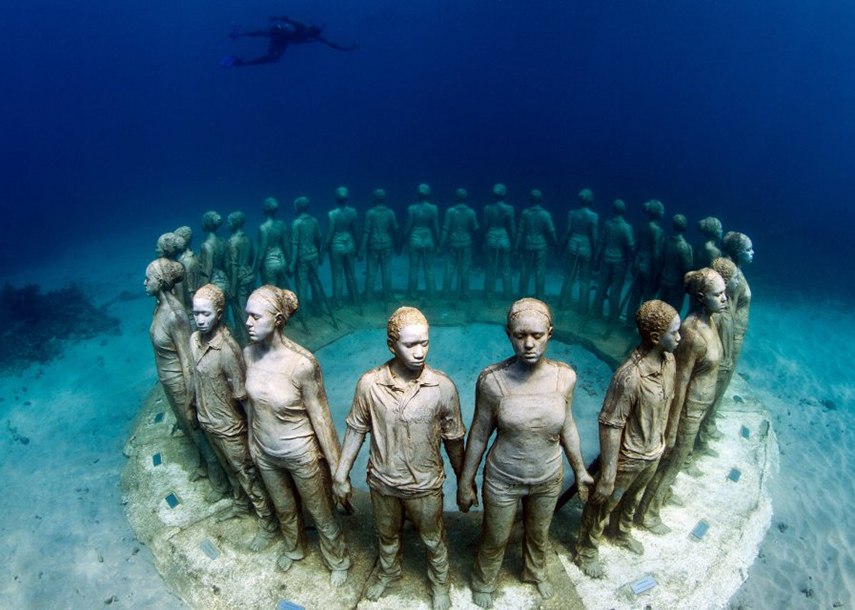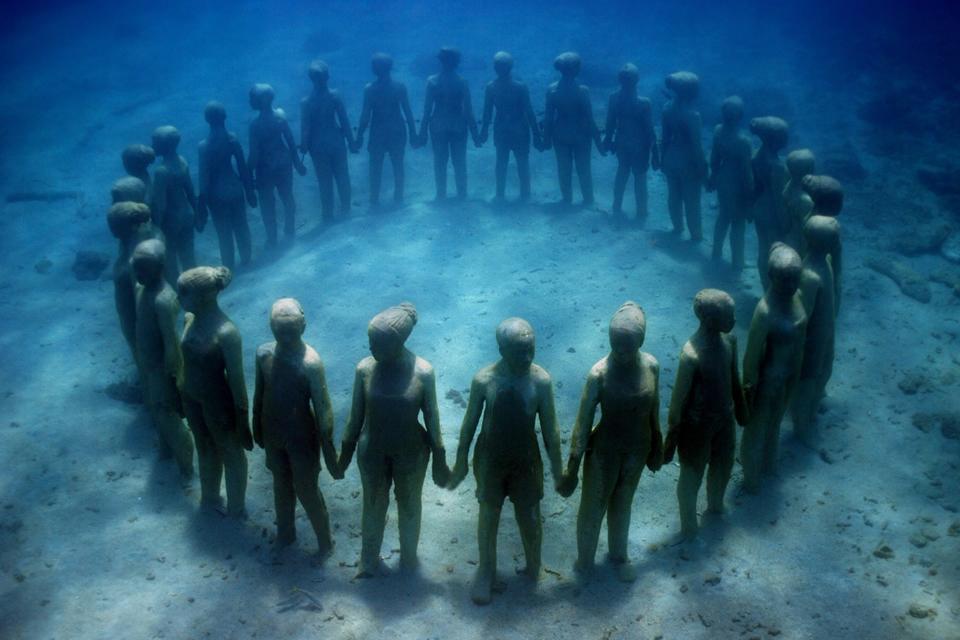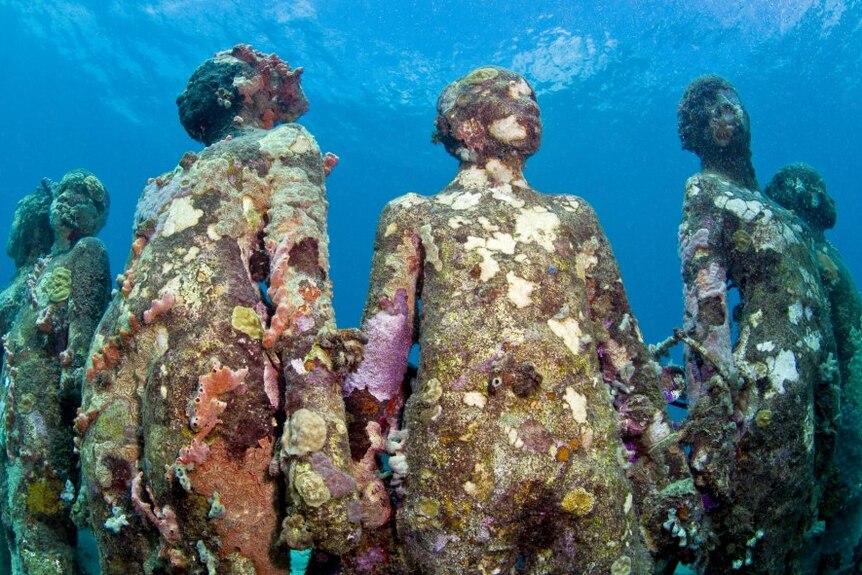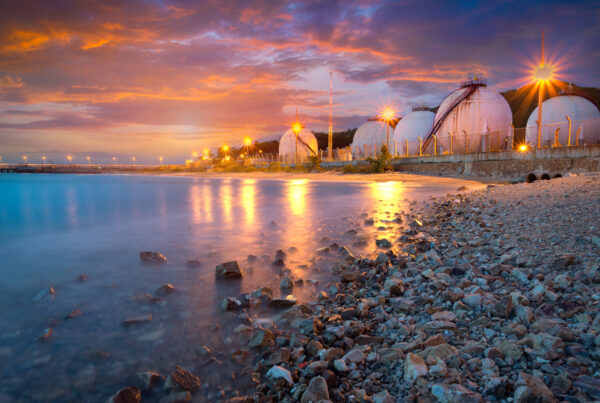Submersion
It is a seemingly easy proposition with an obvious response: jump or dive in. However, as a white-settler researcher, these acts are far from straightforward. To do so unthinkingly could constitute violence against the past and present of so many: those Africans whose bones lie on the seafloor an enduring if invisible testimony to slavery; those whose bodies are twisted by the atrocious labour practices that plague much of the global fishing industries; those whose homes and lives are being swallowed by rising seas; those of the First Nations excluded from their sea countries by settler governments in Australia and elsewhere.
But enter the ocean people do, with various interests and projects. Jason deCaires Taylor’s underwater sculpture has been lauded by many and given numerous awards. Art, science, history, or something else – his work is certainly prolific, populating the ocean floor in eleven countries including those in the Caribbean, as well as Indonesia, the Maldives, Mexico and Australia. His sculpture, Vicissitudes, is particularly thought -provoking: it is certainly art, and it is also science, but is it history?
Image source: ©Jason deCaires Taylor, Vicissitudes 2007. By permission of the artist. https://www.underwatersculpture.com
The underwater sculptures are intended to become the skeleton structure for coral and other marine growth. His website informs that “The works are constructed using pH neutral, environmentally sensitive materials to instigate natural growth and the subsequent changes intended to explore the aesthetics of decay, rebirth and metamorphosis.” Like most of his work, the Vicissitudes sculpture is becoming a living reef transmorphing the 26 life-size children into something quite different.
This is one way to enter the ocean. Given its location in Grenada and the history of transatlantic slavery, many concluded that Vicissitudes was to honour those who died in the Middle Passage. However, such was not deCaires Taylor’s intention, though he freely admitted people could interpret it that way. Rather, it was to help the marine environment and the artificial reefs by redirecting underwater tourists from further damaging the natural reefs.
Does it matter that Vicissitudes entered the ocean not to commemorate the 12.5 million Africans who were ripped from their homes and transported as chattel, in the most inhumane way, to the Americas to work as beasts of burden in the plantation economy?
It isn’t really for me to say. Postcolonial environmental scholar, Elizabeth DeLoughrey has long studied Caribbean history and literature. She places Vicissitudes in relation to Derek Walcott’s representation of the “Caribbean [as] so choke with the dead.” The great Caribbean writer specifies:
. . . them corals: brain, fire, sea fans,
dead-men’s-fingers, and then, the dead men.
I saw that the powdery sand was their bones
ground white from Senegal to San Salvador.
(Collected Poems 349; cited in DeLoughrey, 2017: 35)
DeLoughrey argues that Vicissitudes pushes us into a relation of “thinking with, interacting with — viewing, touching, and perhaps being touched with what Eva Hayward [2010] terms “fingeryeyes” — opens new opportunities for multispecies submarine ontologies. This submersion brings about ethical transformations.” (2017: 42).
I want to conclude this first post on the ethics of entering the ocean by pausing on the immersion and submersion of human bodies in the more-than-human marine. I will return in a later post to the deeply informative work of writers such as Christina Sharpe (2016) and Saidya Hartman (2008) who write through and with the Black bodies of the slave trade and its afterlives. Sharpe’s In the wake is a wake-up call to white settlers like me that there is no easy way to enter the ocean – only tentatively, slowly, reflexively, and ethically in the wake of Black writers and researchers can we enter the riptides of history, memory and politics.
Acknowledging the pragmatics and privilege that allow some to enter the water is paramount. I want to finish with a pressing story about the current excavation of slave shipwrecks. Of the over 1000 slave ships that are thought to have wrecked, only a handful have been excavated. There are many reasons for this lack of interest because the wrecks would hold the torture objects for holding slaves, not gold bullion—and it is expensive work. Unsurprisingly, given the history, Gabrielle Miller (a Black archaeologist at the Smithsonian’s National Museum of African American History and Culture) says that “Black people often have a complicated relationship with water” (2022). Her critique of the unpaid ease with which white people enter the ocean is trenchant: “So long as you expect us to carry your burdens and do your labor for free while you lavish in the abundance it provides, you prove that your colonial mind still runs off the fumes of enslavement.” (2020).
Despite the odds, more and more African and African American people are taking the plunge to further their own research of Black lives drowned. Off the coast of West Africa – the infamous location from where so many slave ships left – the sea floor houses many slave shipwrecks. Ibrahima Thiaw, a Senegalese archaeologist, taught himself how to swim and dive in order to experience and document such a hugely important part of the past and the present of the afterlives of slavery. He now has a research team of young Black African marine archaeologists, in part funded by the Smithsonian’s Slave Wrecks Project.
It was her experience at the Smithsonian’s National Museum of African American History and Culture that prompted Tara Roberts to join with and publicise the group Diving with a Purpose (DWP), about 500 mainly African American divers and amateur archaeologists searching for slave shipwrecks. Roberts quotes legendary diver Albert José Jones, a co-founder of the National Association of Black Scuba Divers and board member of DWP:
“When you are African American and you’re diving on a slave ship, that’s a whole lot different from somebody else doing it … Every time you go down, you realize basically two things: One is that maybe your ancestors were on the ship. The other thing you realize is that you have a history. Your history didn’t start on the shores of the United States. It didn’t start with slavery. Your history started [in] Africa at the beginning of time, the beginning of civilization.” (cited in Roberts, 2022).
Together and across the Middle Passage, they are immersing themselves in history and the ocean. As Black archaeologist Justin P. Dunnavant writes of maritime maroon (escaped slaves): “They used their oceanic literacy to exploit the dialectics of the ocean. The same ocean and wind currents that brought enslaved Africans to the Americas are the same ones self-liberated Africans would use to reclaim their freedom.” (2020: 901). Quoting the celebrated Martinican poet, novelist and theorist, Edouard Glissant (2001: 88), Dunnavant uses his inspiring words to further the entrance of more people of colour into the ocean: “Have confidence in the sea!” (2021: 885).
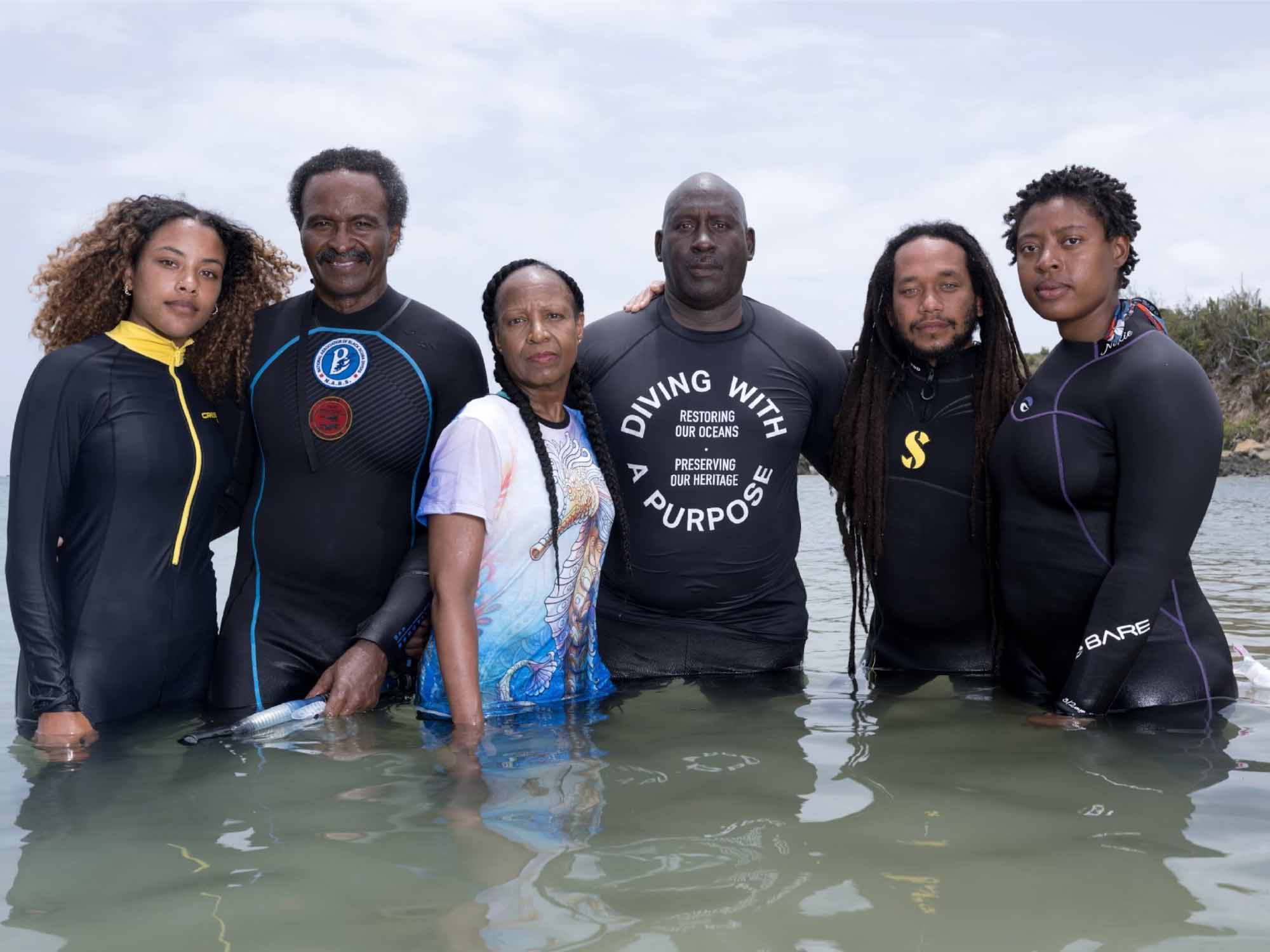
Image: Divers With A Purpose: (L-R) Jewel Humphrey, Kamau Sadiki, Vanessa and Jay Haigler, Dr. Justin Dunnavant and Dr. Ayana Flewellen stand for portraits at Salt Pond Beach, St. John, USVI, Friday, July 22nd, 2021.Photograph Wayne Lawrence. https://www.nationalgeographic.com/podcasts/into-the-depths/article/episode-1-trusting
References
DeLoughrey, Elizabeth. “Submarine futures of the Anthropocene.” Comparative Literature 69, no. 1 (2017): 32-44.
Dunnavant, Justin P. “Have confidence in the sea: Maritime maroons and fugitive geographies.” Antipode 53, no. 3 (2021): 884-905.
Hartman, Saidiya. Lose your mother: A journey along the Atlantic slave route. Macmillan, 2008.
Glissant, Édouard. The Fourth Century. U of Nebraska Press, 2001.
Hayward, Eva. “Fingeryeyes: impressions of cup corals.” Cultural Anthropology 25, no. 4 (2010): 577-599.
Ike, Nkem, Gabrielle Miller, and Gabby Omoni Hartemann. “Anti-racist archaeology: your time is now.” The SAA Archaeological Record 20 (2020): 12-16.
Roberts, Tara. “The search for lost slave ships led this diver on an extraordinary journey” National Geographic Magazine. (Feb. 2022) https://www.nationalgeographic.com/history/article/a-divers-hunt-for-lost-slave-ships-led-to-an-incredible-journey
Sharpe, Christina. In the wake: On blackness and being (2016): 1-24.
Walcott, Derek. Collected Poems, 1948-1984. Macmillan, 1986.
